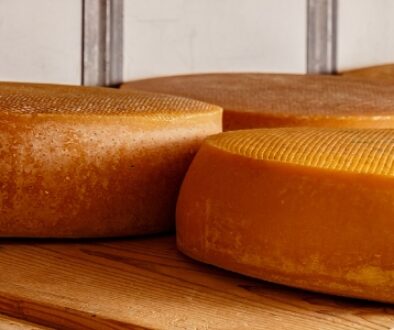Keeping a 5,000-Year-Old Cheese-Making Tradition Alive
Check out this Insider interview with Ruslan about keeping a 5,000-year-old cheese-making tradition alive in Armenia. Watch the video or read the transcript below.
Narrator: This is a type of goat cheese called motal. Using a 5,000-year-old method, motal takes about three months to make. It’s made throughout the Caucasus region, particularly in the mountainous regions of eastern Armenia. This traditional cheese is in danger of disappearing, but one local is working to keep it alive. Meet Ruslan Torosyan. He produces motal cheese in the small town of Chambarak, Armenia, about two hours northeast from the capital. We took the 71-mile drive to meet Ruslan and learn a little bit about motal cheese.
Ruslan: My grandparents were involved in cheesemaking. It’s a cheese that’s a part of this region. But unfortunately, within the next couple of years, it was going to go extinct. Nobody was involved in producing it anymore because it requires a lot of manual labor. We decided as a family to get involved and save this cheese that unfortunately very few people are making.
Narrator: In 2004, Ruslan was traveling around Armenia when he came across shepherds and farmers in mountainous regions of the country making motal inside their homes but not selling it commercially. He and his family worked to bring the cheese to production by collaborating with Slow Food International, an organization that aims to preserve ancient food traditions all over the world. To make the cheese, Ruslan starts by sourcing goat’s milk from local farmers.
Ruslan: First, we take regular milk, goat’s or cow’s milk, and we heat it 30 to 35 degrees Celsius. We add a rennet. It has to be homemade rennet with no chemicals.
Narrator: Rennet is the ingredient that turns milk into cheese. This rennet is made with calf stomach, egg, and salt.
Ruslan: 30 to 40 minutes, with a little bit of heat, we cut the cheese into tiny pieces and drain the water. Then, we transfer the cheese into a container to harden. We leave it in the container for three to four hours, then we transfer the cheese into saltwater. It stays in saltwater for two months. The salt helps the cheese stay fresh because salt is antibacterial and serves as a preservative. After that, the cheese is taken out and broken down by hand, and we add tarragon, green pepper, and/or dill. But sometimes we make it with oregano too. After that, we mix it all and put it in terra-cotta pots and press it down firmly so there’s no air inside.
Narrator: Armenians have been using terra-cotta pots to transfer and preserve food since the third millennium BC. Once the cheese is tightly packed, it’s covered with a cloth.
Ruslan: Then, we flip it down into wood ash. The pot stays upside down in the ash for one month. When the pot is flipped upside down, the ash absorbs the salt water and preserves the cheese. After one month, we seal the pot with natural beeswax. We can keep the cheese for three to four months because there’s no air inside.
Narrator: Even though Ruslan has perfected the traditional cheesemaking method, selling motal comes with obstacles. He cannot sell his cheese in most European countries because the European Union does not authorize the import of all dairy products. Motal is sold primarily in Armenian supermarkets as well as in some restaurants, but selling within the country is also difficult. Since the cheese is handmade at a limited quantity, its cost ranges from 2,300 to 4,500 Armenian drams, which is about $4 to $10. That’s higher than the Armenian market cost of cheese, which is about 1,000 Armenian drams, or $2. Despite international regulations and being far from the capital, Ruslan and his family spread the word by organizing master classes for tourists. They condense the three-month cheesemaking process into an hour and a half to share the ancient technique.
Ruslan: In this job, the most interesting part is that you can do your favorite thing and earn some money. It’s like combining your hobby with a business. You have to love this job. If you don’t love this job, you can’t do it.
Keep Up to Date
Find all of HART Design & Manufacturing current industry news here.
Source: Insider




